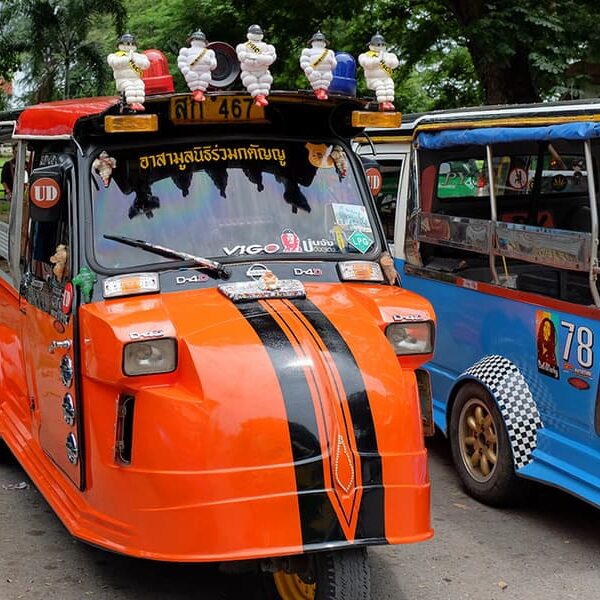The tuk-tuk, also known as an auto rickshaw, is a three-wheeled vehicle that has become a popular mode of transport in many Asian countries. This iconic vehicle has a rich history and has played a significant role in urban transportation in Asia. Let’s delve into the fascinating history of the tuk-tuk.
Origins of the Tuk-Tuk:
The term “tuk-tuk” is believed to have originated from the sound that the early two-stroke engine auto rickshaws made. The repetitive “tuk-tuk” noise produced by the engine as it idled or accelerated is thought to have inspired the name. This onomatopoeic term quickly caught on and became widely used to describe these vehicles in many Asian countries.
The origin of the tuk-tuk can be traced back to post-World War II Japan, where the concept of a motorized three-wheeled vehicle was first introduced. These early vehicles were primarily used for transporting goods and were known as “cabin scooters.”
Introduction to Asia:
The concept of the motorized three-wheeler was later introduced to Asian countries, including Thailand, India, and the Philippines, where it quickly gained popularity as a convenient and affordable mode of transportation, especially in crowded urban areas.
Evolution of the Tuk-Tuk:
Over the years, the design of the tuk-tuk has evolved, with different countries and regions putting their own unique spin on the vehicle. In Thailand, for example, the tuk-tuk is known for its colorful and ornate decorations, while in India, it is often a more utilitarian vehicle with a simple design.
Tuk-Tuks in Modern Times:
Today, tuk-tuks continue to be a popular mode of transport in many Asian countries, offering a convenient and cost-effective way to navigate busy city streets. In recent years, there has been a growing interest in electric tuk-tuks as a more environmentally friendly alternative to traditional gasoline-powered vehicles.
Benefits of Tuk-Tuks:
- Compact size: Tuk-tuks are smaller than traditional cars, making them ideal for navigating narrow streets and congested traffic.
- Cost-effective: Tuk-tuks are often more affordable than taxis or other forms of public transportation, making them a popular choice for budget-conscious travelers.
- Versatility: Tuk-tuks can be used for both short trips around town and longer journeys, making them a flexible mode of transport.
Challenges and Controversies:
While tuk-tuks offer many benefits, they are not without their challenges. In some cities, tuk-tuks have been criticized for contributing to air pollution and traffic congestion. Additionally, there have been concerns about safety standards and the regulation of tuk-tuk drivers.
The Future of the Tuk-Tuk:
Despite these challenges, the tuk-tuk remains an iconic symbol of Asian transportation. As urban areas continue to grow and evolve, the tuk-tuk is likely to remain a popular mode of transport, offering a unique and memorable experience for both locals and tourists alike.
Comparison of Tuk-Tuks in Different Asian Countries
| Country | Characteristics |
| Thailand | Colorful decorations, open-air design |
| India | Utilitarian design, often diesel-powered |
| Philippines | Variants include the “tricycle” and “motorela” |
Interesting Facts about Tuk-Tuks:
- Global Variations: While “tuk-tuk” is the common term used in many countries, different regions have their own names for these vehicles. For example, in India, they are often called “auto-rickshaws” or simply “autos,” while in the Philippines, they are known as “tricycles” or “trikes.”
- Evolution of Design: Over the years, the design of tuk-tuks has evolved to suit local needs and preferences. In some countries, tuk-tuks are brightly decorated with colorful patterns and lights, while in others, they are more utilitarian in design.
- Economic Impact: Tuk-tuks play a crucial role in many Asian economies, providing employment for drivers and affordable transportation for locals and tourists alike. They are often seen as a symbol of entrepreneurship and innovation in urban transportation.
- Environmental Concerns: While tuk-tuks offer a convenient mode of transport, especially in congested urban areas, they have also been criticized for their contribution to air pollution and traffic congestion. Some cities are exploring ways to make tuk-tuks more environmentally friendly, such as promoting electric or hybrid models.
- Cultural Significance: Tuk-tuks have become more than just a mode of transport; they are cultural icons that reflect the vibrancy and diversity of Asian societies. They feature prominently in local art, music, and literature, and are often used as symbols of urban life in Asia.
The tuk-tuk is more than just a mode of transport; it is a cultural icon that embodies the spirit of innovation and adaptability in Asian countries. As cities continue to grow and evolve, the tuk-tuk is likely to remain a familiar sight on the streets, offering a unique and memorable way to experience urban life in Asia.
